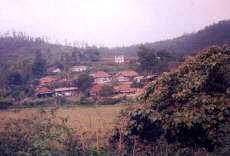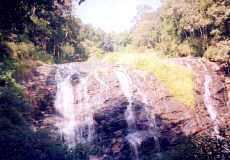Folk Tales from the Scotland of India
Coorg & Bangalore


Happy valley and the cottages at Coorg.
![]()
![]()
I just had to see it. After all, the Cauvery River is called the Ganges of the South. And the Ganges is the most awesome and revered river in India.
So, when my serious ‘looking’ colleague dubbed as ‘Dr. Know it All’, mentioned that Coorg district, the source of the Cauvery River, is just a six-hour drive away from our office, situated on a busy street in Bangalore, I just could not resist running away.
Armed with my leave application in hand, I barged into the partner’s cabin. After all, it was a plea for just a day’s leave, even though it was during a hectic tax-return filing season. With the weekend thrown in for good measure, I would get to spend three days in Madikeri, one of the districts of Coorg.
An early morning start, the next day at 6 am, had us (my parents had decided to make it a family holiday) winding up the steep hills of Madikeri situated 1,500 feet above sea level. White cottages with red-tiled roofs, each with its well-maintained garden or window boxes just overflowing with flowers – the yellow alamandas, the bright red hibiscus, the bougainvilleas in various hues, purple African violets; sprung up on all sides, down the valley, up the hills, tucked away around the corner of the steep curving road. As the pleasant smell of coffee wafted into the air, all my cares vanished. I had reached the Scotland of India. Only the bagpipers were missing.
With its mist-covered hills, deep green valleys, waterfalls and streams in the most unexpected places, chirpy birds, and smiling people, Coorg is a trekker’s paradise for those in Bangalore who want to get away for the weekend.
The first day was spent exploring the nearby tourist sites. We began with Maikeri Fort, a 19th-century fort that has witnessed several battles. A mud fort built by a Lingayat ruler was replaced by a stronger stone structure built by Tipu Sultan, the Moghul ruler. The Lingayats with British help managed to overthrow the Moghul king and wrest back the fort.
This fort now houses, can you believe it, offices of the district administration. Friendly bureaucrats, these. They don’t really mind tourists snooping around, and if lucky, someone may even offer a cup of coffee.
Two black, life-sized elephants made of stone (I think) and a steep flight of steps seemed intriguing. Scrambling up, I found that I was looking down at the local prison! Quite an anti-climax!
As for the elephants, there lies another interesting story. Folklore has it that one of the Ligayat kings had his favorite elephants slain because they disturbed his sleep. Filled with remorse, he later had the statues of these elephants erected and they still stand. A museum and a temple in this complex, were however locked, so we headed for Raja’ seat. Once only the kings paraded the grounds, today it is a well-maintained public park – admission free. Cement seats scattered around the park enable tourists to watch nature unfold its myriad hues in absolute luxury. Try the bhel-puri (a popular snack) sold outside the park and down it with a cup of coffee. Unfortunately it is not Coorg coffee, but Nescafe from the coffee machine.


Abbey falls – well, the top half, anyway!
![]()
![]()
Abbey Falls was next. Leaving my parents to witness the sunset, I decided to trek to the falls. But a 7-kilometer trek, on steep hillsides, even if on well-maintained tarred roads was quite an effort for a city slicker like me. I will never forget the enterprising kid, Gopal, who sold me a fresh coconut water with a teaspoon of fragrant Coorg honey stirred in. Later, I found that this very drink was in fact a mock-tail at the hotel’s restaurant.
A small sign atop an equally small gate announced that I had reached Abby Falls. I almost felt that I was trespassing. Set amidst coffee and cardamom plantations, a flight of steps lead you down to the falls. There are strict instructions not to damage the trees and plants. The plantations seemed to be well-maintained private property.
The sound of rushing water is sheer music. The water drops down from 70 feet; only the noisy tourists who were actually bathing (with soap) spoiled the scene. The water, however, did not flow from the Cauvery River, but from a spring. As I sat back in an auto (a three wheeler contraption) and headed back to the hotel, I knew that from tomorrow I would track down the Cauvery River.
——–